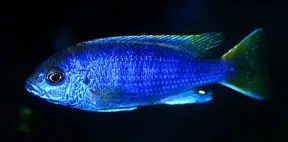Pseudotropheus sp. 'acei'
Classification
Order: Perciformes Family: Cichlidae
Distribution
Endemic to Lake Malawi. It is found on the lake’s western side, around Nkhata Bay, Senga Bay, Ngara, Ruarwe, Bandawe, Karonga and the South Rukuru River.
Habitat
It inhabits both rocky and sandy shorelines but tends to be associated with submerged rocks and other objects in the latter case.
Maximum Standard Length
100 – 125 mm.
Maintenance
Use piles of rocks to form cave-like structures and hiding places, leaving areas of open water for swimming. The rockwork should be piled quite high as this species tends to inhabit the upper half of the aquarium. A substrate of sand is preferable. Although not essential, pieces of bogwood can be used to replicate the natural environment of the fish, provided the water is well-buffered.
Water Conditions
Temperature: 75-82°F (24-28°C)
pH: 7.6-8.8
Hardness: 10-25°H
Diet
It will accept most foods offered but vegetable matter in the form of spirulina flakes, blanched spinach, nori etc. should form a large proportion of the diet. This can be supplemented with live and frozen varieties. Never feed beefheart or any other red meat as it interferes with the digestive system of these fish.
Behaviour and CompatibilityTop ↑
Not especially aggressive for a mbuna. It should not be kept with large mbuna or other boisterous fish but does well with the moderately aggressive species. Other possible tankmates include Aulonocara, Copadichromis and other quieter Malawi cichlids. Male fish are territorial but even this is not as pronounced as in most mbuna. Several males can be kept in a suitably large aquarium and each should be provided with several females.
Sexual Dimorphism
Not easy to sex. Both sexes exhibit similar colouration and possess egg spots in the anal fin. Male fish however tend to grow larger and are more brightly coloured when inbreeding condition. The egg spots in males tend to be more numerous and more intense in colour. The easiest way to sex it is by observing its behaviour. As with other mbuna males are the more territorial sex and are often seen chasing females and other species in the tank. Obviously it can also be sexed by examination of the vents, but this approach is for experts only.
Reproduction
Possible. Maternal mouthbrooder. It should be spawned in a species tank in a harem of one male and at least 3 females. A 48″ aquarium is a good size (although larger is preferable) and this should be furnished as suggested above, along with some flat stones and areas of open substrate to act as potential spawning sites. The pH should be around 8.2-8.5 and the temperature 77-80°F. Condition the fish with a high quality diet composed mainly of vegetable matter.
The male fish will clean and then display around his chosen spawning site, showing intense colour, and attempt to entice females to mate with him. He is quite vigorous in his pursuits and it is in order to dissipate this aggression that we spawn this species in a harem. When a female is willing, she will approach the spawning site and lay her eggs there, after which she picks them up in her mouth. The male fish has egg-shaped spots on his anal and the female is attracted to these. When she tries to add them to the brood in her mouth she actually recieves milt from the male, thus fertilising the eggs.
The female will carry the eggs for around 3-4 weeks before releasing the free swimming fry. She will not eat during this period and can be easily spotted by her distended mouth. If a female is overly stressed she may spit out the brood prematurely or eat them, so care must be taken if you decide to move the fish in order to avoid fry predation or harassment by the males. Some breeders artificially strip the fry from the mother’s mouth at the 2 week stage and raise them from that point as this usually results in a larger number of fry.
The fry are large enough to take brine shrimp nauplii, microworm and powdered dried foods from birth.
NotesTop ↑
This is an excellent beginner’s species as it is relatively peaceful and easily bred. Despite being undescribed to science it is widely available in the hobby. It is sometimes sold as Gephyrochromis acei. Several colour forms are available, including “yellow tail acei” and “white tail acei”. None of these should be kept together in aquaria to prevent hybridisation.
In nature it feeds specifically on algae and other organisms growing on submerged wood, and is the only known mbuna to do so exclusively. It can be seen gathering in schools around tree branches and logs. As with other members of the genus it possesses flat, bicuspid teeth which are designed for scraping algae from the surface of rocks, or in this case, wood. Interestingly although male fish are territorial in the aquarium and may build nests in which to spawn, this behaviour has not been recorded in the wild.


